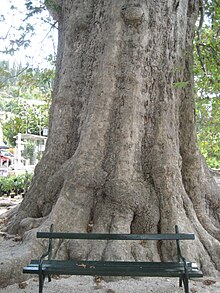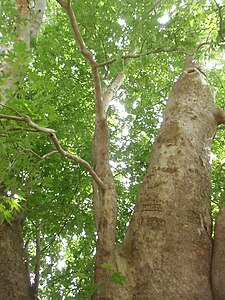Platanus
| Platanus Temporal range:
| |
|---|---|

| |
| Leaves and fruit of a London plane | |
| Scientific classification | |
| Kingdom: | Plantae |
| Clade: | Tracheophytes |
| Clade: | Angiosperms |
| Clade: | Eudicots |
| Order: | Proteales |
| Family: | Platanaceae |
| Genus: | Platanus L. |
| Species | |
|
See text | |
Platanus (/ˈplætənəs/ PLAT-ən-əss[1]) is a genus consisting of a small number of tree species native to the Northern Hemisphere. They are the sole living members of the family Platanaceae.
All mature members of Platanus are tall, reaching 30–50 m (98–164 ft) in height. All except for
They are often known in English as planes or plane trees. A formerly used name that is now rare is plantain tree (not to be confused with other, unrelated, species with the name).[2] Some North American species are called sycamores (especially Platanus occidentalis),[3] although the term is also used for several unrelated species of trees. The genus name Platanus comes from Ancient Greek πλάτανος, which referred to Platanus orientalis.[4]
Botany


The flowers are reduced and are borne in balls (globose heads); 3–7 hairy
After being pollinated, the female flowers become
The leaves are
The mature bark peels off or exfoliates easily in irregularly shaped patches, producing a mottled, scaly appearance. On old trunks, bark may not flake off, but thickens and cracks instead.[citation needed]
Phylogeny
There are two subgenera, subgenus Castaneophyllum containing the anomalous
- Platanus palmeri (= P. occidentalis var. palmeri) – forming the southwesternmost populations of P. occidentalis s.l.[6][7] – carries nuclear intron sequences (second intron of the Leafy gene) of PNA-E origin.[6] It lacks the plastid haplotype specific for the northeastern populations (P. occidentalis s.str.)[7]
- The common ancestorof P. rzedowskii and P. occidentalis s.l. had been in contact with a member of the PNA-E clade.
- Likewise, P. rzedowskii from Nuevo León is a genetic mosaic, and may have originated from earlier hybridization within the ANA clade, between southernmost P. occidentalis s.l. (P. palmeri) and P. mexicana s.l., or their ancestors.[6] Today the ranges of P. occidentalis s.l. and P. mexicana s.l. are mutually exclusive. Platanus rzedowskii is geographically and morphologically intermediate between P. occidentalis s.l. and P. mexicana s.l.[5][7]
- Morphological reinvestigation including the originally collected material revealed that the interior populations of P. mexicana (northern nothospecies: P. × mexicana.[10] The remaining populations of P. mexicana s.l., P. lindeniana, show no sign of introgression from either P. rzedowskii, P. occidentalis-palmeri or the Western North American species (P. racemosa species aggregate),[6][7] with the exception of one heterozygotic P. oaxacana population from northcentral Oaxaca.[7]
The genus Platanus exemplarily illustrates the concept of a Coral of Life, a species network. Its modern-day species are not only the product of evolutionary dichotomies (cladogenesis), the splitting of an ancestral lineage into two (Tree of Life metaphor) but also evolutionary anastomoses: hybridization and introgression.
The fossil record of leaves and fruit identifiable to Platanus begins in the
-
The 2043–2044-year-old Platanus orientalis tree Tnjri in Nagorno-Karabakh.
-
Miocene Platanus dissecta leaf, Latah Formation
Species
The following are recognized species of plane trees:
| Botanic name | Common names | Distribution and taxonomic notes | Flowerheads | Systematics |
|---|---|---|---|---|
Willd.
|
London plane, hybrid plane | Worldwide, cultivated origin;
hybrid of P. occidentalis and P. orientalis |
1–6 | Subgenus Platanus;
interlineage hybrid |
| Chiapas plane | Mexico (Chiapas);
part of P. mexicana species aggregate, probably a junior synonym of P. lindeniana[6][7] |
2–7[10] | Subgenus Platanus,
ANA clade | |
| Platanus gentryi Nixon & J.M.Poole IPNI | Gentry's plane | Mexico (tripoint area of Chihuahua, Sinaloa and Sonora);
part of the P. racemosa species aggregate |
? | Subgenus Platanus,
PNA-E clade |
Gagnep. |
Kerr's plane | Laos, Vietnam | 10–12 | Subgenus Castaneophyllum |
| Platanus mexicana Moric. sensu lato | Mexican sycamore, Mexican plane | Mexico, Guatemala;
in a strict sense synonymous with P. mexicana var. interior Nixon & Poole, restricted to Guanajuato, Hidalgo, Querétaro and San Luis Potosí, and of hybrid origin[10] |
s.l.: 1–7
s.str: 1–3[10] |
Subgenus Platanus.
ANA clade |
| Platanus lindeniana M.Martens & Galeotti IPNI | Mexico (Chiapas, Hidalgo, Puebla, Oaxaca, Veracruz), Guatemala;
part of P. mexicana species aggregate, synonymous with P. mexicana var. mexicana according Nixon & Poole[5][10] |
(1–)2–5(–7)[10] | Subgenus Platanus,
ANA clade | |
Platanus oaxacana Standl. |
Oaxaca plane | Mexico (Oaxaca); part of the P. mexicana species aggregate, | 2–4[10] | Subgenus Platanus,
ANA clade |
| Platanus occidentalis L. | American sycamore, American plane, buttonwood, occidental plane, water beech | Canada (Ontario), United States | 1–2 | Subgenus Platanus,
ANA clade |
| Platanus palmeri (Kuntze) ined. | Mexico (Coahuila) and United States (Texas) | 1–2 | Subgenus Platanus,
ANA clade | |
| Platanus rzedowskii Nixon & J.M.Poole IPNI | Rzedowski's plane, Rzedowskii's sycamore | Mexico (Nuevo León, San Luis Potosí, Tamaulipas) | 1–2 | Subgenus Platanus,
ANA clade |
| Platanus orientalis L. | Oriental plane | Eurasia | 3–6 | Subgenus Platanus
PNA-E clade |
| Platanus racemosa Nutt. | California sycamore, western sycamore, aliso | United States (California), Mexico (Baja California) | 3–7 | Subgenus Platanus
PNA-E clade |
| Platanus wrightii S.Watson | Arizona sycamore | United States (Arizona, New Mexico), Mexico (Sonora, Chihuahua);
part of the P. racemosa species aggregate |
2–4 | Subgenus Platanus
PNA-E clade |
Diseases

Planes are susceptible to plane anthracnose (Apiognomonia veneta), a fungal disease that can defoliate the trees in some years. The most severe infections are associated with cold, wet spring weather. P. occidentalis and the other American species are the most susceptible, with P. orientalis the most resistant. The hybrid London plane is intermediate in resistance.
Ceratocystis platani, a wilt disease, has become a significant problem in recent years in much of Europe.[12] The North American species are mostly resistant to the disease, with which they probably coevolved, while the Old World species are highly sensitive.
Other diseases such as powdery mildew occur frequently, but are of lesser importance.
Platanus species are used as food plants by the
In the 21st century a disease, commonly known as Massaria disease, has attacked plane trees across Europe. It is caused by the fungus Splanchnonema platani, and causes large lesions on the upper sides of branches.[13][14]
Effects on humans
There have been cases of "platanus cough", symptoms of shortness of breath, coughing, and irritated eyes, which may affect several people in a place, and have led to initial suspicion of an attack with an irritant gas. After one such mass attack which affected schoolchildren in classrooms with open windows densely surrounded by plane tees, children had to be admitted to hospital, where they were treated and recovered without ill effects. It was found that the symptoms were due to the fine star-shaped trichomes (hairs) on all parts of platanus trees, which are broken off by strong wind after a prolonged dry period. The dust created causes direct irritation and scratchiness in the eyes, throat, and nose, but not the runny nose and itching eyes and nose caused by an allergy. The school incident took place after a dry period, with a fairly high temperature of 29°C, and wind gusting at 50 km/h.[15]
Protection against platanus cough is provided by avoiding contact and wearing protective glasses and masks under weather conditions promoting release of trichomes. When cleaning in an urban environment, sweeping up fallen leaves and branches can release hairs; cleaning by suction is preferred. It is not recommended that trees in cities be felled, as they are beneficial; in particular the platanus trichomes act as biofilters for air pollutants. Where there are urban concentrations presenting a risk, seasonal spraying of trees with a solution of apple pectin can prevent the star hair from breaking off.[15]
Uses
The principal use of these trees is as ornamental trees, especially in urban areas and by roadsides. The
Cultural history
Most significant aspects of cultural history apply to ", which the title character sings in praise of his favorite plane tree.
The plane tree has been a frequent motif featured in Classical Chinese poetry as an embodiment of sorrowful sentiments due to its autumnal shedding of leaves.[citation needed]
The legendary Dry Tree first recorded by Marco Polo was possibly a platanus. According to the legend, it marked the site of the battle between Alexander the Great and Darius III.
The German camouflage pattern Platanenmuster ("plane tree pattern"), designed in 1937–1942 by Johann Georg Otto Schick, was the first dotted camouflage pattern.[17]
Footnotes
- ^ Sunset Western Garden Book 1995.
- ^ "plantain, n.2". Oxford English Dictionary (Online ed.). Oxford University Press. (Subscription or participating institution membership required.)
- ^ Merriam Webster.
- Perseus Project
- ^ S2CID 90869751.
- ^ .
- ^ PMID 23798602.
- ^ S2CID 86021109.
- ^ PMID 18089582.
- ^ S2CID 84804295.
- doi:10.26879/906.
- ^ Pathology note 7 2008.
- ^ "Massaria disease". Forestry Commission. Retrieved November 7, 2012.
- ^ "Massaria disease of plane trees". Treetree. Retrieved November 7, 2012.
- ^ a b Eppinger, Ute (15 April 2024). "What Are Platanus Cough and Thunderstorm Asthma?". Medscape.
- ^ Marzano, Annalisa (May 20, 2020). "Walking, talking and showing off – a history of Roman gardens". The Conversation.
- ISBN 978-1-84176-854-0.
References
- Books
- Naumann, Helmut (2007). "Die Platane von Gortyna". In Kämmerer., Thomas Richard (ed.). Studien zu Ritual und Sozialgeschichte im Alten [Orient / Studies on Ritual and Society in the Ancient Near East. Tartuer Symposien 1998–2004]. Berlin, de Gruyter. pp. 207–226.
{{cite book}}: CS1 maint: location missing publisher (link) - Sunset Western Garden Book. 1995. pp. 606–607.
- Journals
- Feng, Y.; Oh, S.H.; Manos, P. S. (2005). "Phylogeny and Historical Biogeography of the Genus Platanus as Inferred From Nuclear and Chloroplast DNA". Systematic Botany. 30 (4): 786–799. S2CID 86021109.
- Nixon, K. C.; Poole, J. M. (2003). "Revision of the Mexican and Guatemalan species of Platanus (Platanaceae)". Lundellia. 6: 103–137. ]
- Web
- "Sycamore", Merriam-Webster Online Dictionary, retrieved 2009-08-04
- "Pathology note 7" (PDF). The Research Agency of the Forestry Commission. 2008.
External links
- Botany of plane trees
- A short informal account concentrating on the North American species
- A developmental and evolutionary analysis of embryology in Platanus (Platanaceae), a basal eudicot, abstract of article by Sandra K. Floyd et al. in American Journal of Botany, 1999;86:1523–1537.
- Photos, measurements, and location details of large plane trees worldwide


